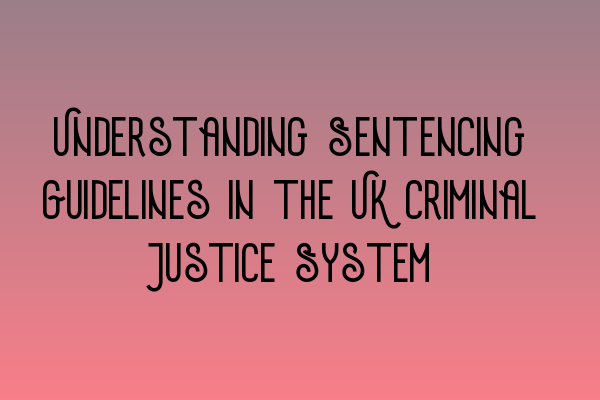Understanding Sentencing Guidelines in the UK Criminal Justice System
As experienced solicitors at SQE Criminal Law & Practice Law UK, we understand the importance of comprehending sentencing guidelines in the UK criminal justice system. Sentencing plays a crucial role in determining the outcome of a criminal case, and it is vital for both legal professionals and the general public to have a clear understanding of these guidelines.
What are Sentencing Guidelines?
Sentencing guidelines are a set of rules and principles that judges refer to when determining the appropriate punishment for a criminal offence. These guidelines are created by the Sentencing Council, an independent body responsible for promoting consistency and transparency in sentencing across England and Wales.
Types of Sentencing
There are various types of sentencing that can be imposed, depending on the severity of the offence and the specific circumstances of the case. Some common types of sentencing include:
- Discharge: A discharge is a form of punishment where the offender is not further penalised, but a conviction is recorded.
- Fines: Fines require the offender to pay a certain amount of money as a penalty for their actions.
- Community Orders: Community orders involve the offender carrying out unpaid work or participating in specific programs aimed at rehabilitating them.
- Suspended Sentence: A suspended sentence involves the offender being given a custodial sentence, but the execution of the sentence is suspended for a specified period.
- Imprisonment: Imprisonment is the most severe form of punishment, where the offender is sentenced to a specified period of time in prison.
Factors Affecting Sentencing
When determining an appropriate sentence, the judge takes into account various factors, including:
- Severity of the Offence: The seriousness of the offence is a key factor in sentencing. More severe offences typically result in longer sentences or harsher penalties.
- Aggravating and Mitigating Factors: Aggravating factors, such as premeditation or use of a weapon, can increase the sentence, while mitigating factors, such as remorse or cooperation with the authorities, can lead to a reduced sentence.
- Previous Convictions: The offender’s previous criminal record, if any, is taken into consideration when determining the sentence.
- Victim Impact: The impact of the offence on the victim, including physical and emotional harm, is considered during sentencing.
Importance of Understanding Sentencing Guidelines
Understanding sentencing guidelines is crucial for various reasons:
- Transparency: Sentencing guidelines ensure transparency in the justice system, as they provide a clear framework for determining the appropriate punishment.
- Consistency: The use of sentencing guidelines promotes consistency in sentencing across different cases, preventing disparities and ensuring fair treatment.
- Case Preparation: Legal professionals must be well-versed in sentencing guidelines to effectively represent their clients and prepare their cases accordingly.
- Public Awareness: By understanding sentencing guidelines, the general public can gain insight into how the criminal justice system operates and the consequences of criminal behaviour.
Stay Informed with SQE Criminal Law & Practice Law UK
At SQE Criminal Law & Practice Law UK, we are dedicated to providing reliable and up-to-date information on various legal topics. Whether you are preparing for the SQE exams or seeking guidance on criminal law practices, our comprehensive articles, courses, and practice exams can assist you.
For additional practice resources to help you prepare for the SQE exams, take a look at our related articles:
- SQE 1 Practice Exam Questions
- SQE 1 Practice Mocks FLK1 FLK2
- SQE 2 Preparation Courses
- SQE 1 Preparation Courses
- SRA SQE Exam Dates
Stay informed and stay ahead with SQE Criminal Law & Practice Law UK!
